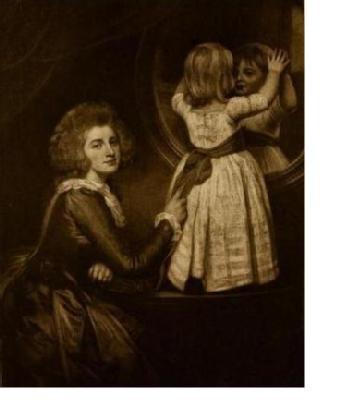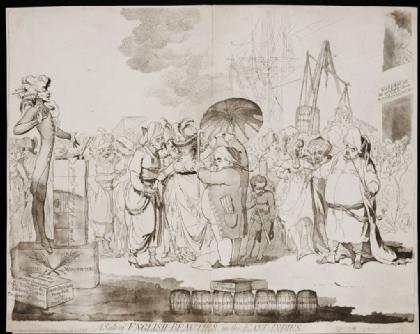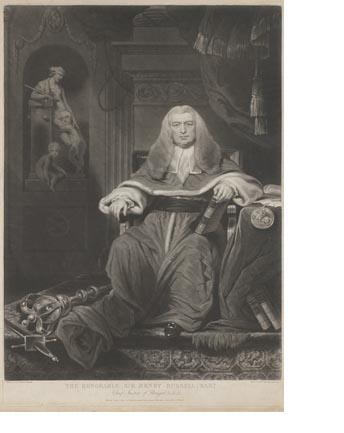The Russells of Swallowfield Park

The Russell family purchased Swallowfield Park in the mid 1820s. By 1826 they had begun to renovate the house. This section gives an overview of who the Russells were and what they did to Swallowfield Park. We've included a timeline about the Russells at the bottom of this page.
Who Were the Russells?
Sir Henry Russell, first baronet (1751-1836) had been born in Dover, the son of a merchant. Educated at Charterhouse and Cambridge, Russell trained in the law at Lincoln’s Inn. His legal ability and a strategic marriage combined to raise his social aspirations and economic prospects. In 1782, as a widower, Russell took as his second wife Anne Barbara Whitworth (d. 1814), the youngest daughter of Sir Charles Whitworth (c. 1721-1778) and sister to Charles, Earl Whitworth (1752-1825).
In 1797 Russell was knighted and appointed a judge of the Bengal Supreme Court. India became the making of the Russell family. The judge reached Bengal in 1798, where his eldest son Henry (1783-1852) took up an appointment in the East India Company’s civil service. In 1800, Henry was appointed assistant to the Resident of Hyderabad. (The Resident was the British political agent, or diplomat, to the Hyderabad court, whose ruler was the Nizam of Hyderabad). The Russell family’s domestic life in India centred around three main urban hubs: Calcutta, Hyderabad and Madras. From 1798 until his departure for England in 1813, Sir Henry presided over his often distant family from his home in Chowringhee, Calcutta.
Lady Russell and Son (from the original at Swallowfield by George Romney, R.A., painted in 1786-7). The image appears in the frontispiece of Lady Russell, Swallowfield and its Owners (London, New York and Bombay: Longmans, Green and Co., 1901 . It seems likely that Lady Russell is depicted here with her eldest son Henry. Notice the importance that the portraitist places on Henry's engagement with the mirror. His later correspondences demonstrate how Henry continued to have a fascination with objects throughout his life.
. It seems likely that Lady Russell is depicted here with her eldest son Henry. Notice the importance that the portraitist places on Henry's engagement with the mirror. His later correspondences demonstrate how Henry continued to have a fascination with objects throughout his life.
The younger Russell children remained in England, but Lady Anne (having given birth to her ninth child in December 1797) soon set sail for Bengal with her nieces Mary Lloyd and Rose Aylmer (1779-1800) in tow—both joining the so-called ‘fishing fleet’ of nubile British daughters who tried their fortunes on the colonial marriage market.

'A sale of English beauties in the East Indies', James Gillray, 1786, Print on wove paper: etching and aquatint, 786.05.16.05. Courtesy of The Lewis Walpole Library, Yale University . The print depicts female experiences of India and the Indian marriage market as akin to the market place. In the centre of the image men barter and parry over a women who seems to have little more agency than a teapot. What do you see in this print? What is your interpretation? Please let us know in the comments box below.
. The print depicts female experiences of India and the Indian marriage market as akin to the market place. In the centre of the image men barter and parry over a women who seems to have little more agency than a teapot. What do you see in this print? What is your interpretation? Please let us know in the comments box below.
The reunited Russells now settled in Calcutta (present-day Kolkata), where the street on which they lived continues to bear their name. The couple’s two youngest children were both born in India. Rose Aylmer (1800-1889) was named to commemorate her cousin, who had died of a tropical fever before she could secure a husband, and George Lake (b. 1802) was named for the first Viscount Lake of Delhi (1744-1808), commander-in-chief of the army in India and a distant relation. Two further sons later joined their father in Bengal. Charles Russell (1786-1856) had arrived at his parents’ Calcutta home by 1802, a cadet in the Company’s Bengal army. The couple’s third son, the feckless Francis Whitworth Russell (1790-1852), was appointed to the Bengal civil service in 1808, and remained in India, with only short sojourns home, until his death.
Do you have an image of 'Russell Street' in Calcutta? Or, are you researching Rose Aylmer or George Lake? If so please contact us via the comments box below.
 ) was taken to Madras by his career and here he married Jane Casamaijor, the daughter of Madras civil servant James H. Casamaijor. She, however, died in December after contracting an agonising tropical disease and Henry was left distraught. His prospects improve in 1810 when, after a brief interval in Poona (Pune), he was finally appointed the Resident of Hyderabad. Charles acted as his assistant and the two brothers remained in Hyderabad for almost a decade.
) was taken to Madras by his career and here he married Jane Casamaijor, the daughter of Madras civil servant James H. Casamaijor. She, however, died in December after contracting an agonising tropical disease and Henry was left distraught. His prospects improve in 1810 when, after a brief interval in Poona (Pune), he was finally appointed the Resident of Hyderabad. Charles acted as his assistant and the two brothers remained in Hyderabad for almost a decade. In 1813 Sir Henry returned to England and set up home in London at 62 Wimpole Street. His return was timely as less than a year later Lady Anne died. During this time Sir Henry contemplated buying a country estate but was thwarted in his plans by being unable to find a suitable house.
In 1813 Sir Henry returned to England and set up home in London at 62 Wimpole Street. His return was timely as less than a year later Lady Anne died. During this time Sir Henry contemplated buying a country estate but was thwarted in his plans by being unable to find a suitable house.
In 1816, unbeknownst to his family Henry had married Clotilde Mottet, a Catholic. In doing so, he made re-joining the English elite much more difficult. Nevertheless, Sir Henry soon became reconciled to the marriage and the couple returned to England in 1820. On their return they leased Sutton Park in Bedfordshire, but by the mid-1820s their abode changed and they set up a more permanent home at Swallowfield Park.
Clotilde is possibly one of the women featured in Richard T. Lonsdale's 1843-44 painting 'The Drawing Room at Whittington Hall, Lancashire' . The East India Company at Home, 1757-1857 project would like to find a similar sort of interior image for Swallowfield Hall. If you know of any contact us via the comments box below. Furthermore, if you have any information on the Mottet family, please get in touch.
. The East India Company at Home, 1757-1857 project would like to find a similar sort of interior image for Swallowfield Hall. If you know of any contact us via the comments box below. Furthermore, if you have any information on the Mottet family, please get in touch.
After purchasing Swallowfield Park in the mid-1820s, the Russell family were faced with daunting task of making it their family home. Between 1824 and 1826 Henry Russell employed William Atkinson, who had trained under James Wyatt. Prior to working on Swallowfield, Atkinson had remodelled Chequers in Buckingham in 1823 and between 1816 and 1823 renovated Scone Palace for Sir Walter Scott. At Swallowfield he refashioned the exterior and carried out an internal remodelling. Although Henry employed an architect famous for his Gothic style, Swallowfield remained neo-classical in style. Despite this stylistic continuity, the refashioning of Swallowfield was extensive and Henry and Clotilde were forced to move their family out of the house while it took place.
 , George Chinnery, engraved by Samuel William Reynolds
, George Chinnery, engraved by Samuel William ReynoldsSir Henry Russell's appointment as Chief Justice of the Supreme Court of Bengal had been marked in 1807 with a commission by 'the native inhabitants of Bengal' for a vast portrait of the newly elevated judge. Brought from Madras to Calcutta to execute this commission, George Chinnery (1774-1852) was Russell's private guest during the three months it took to complete the painting, which was freighted with allegorical emblems of the virtues of British justice for Bengal's indigenous and colonial populations. A more modest replica of this portrait was sent to London, where an engraving by Samuel William Reynolds underpinned circulation of Russell's image - and his new status - in the metropolis. Intent to build upon this precedent and to delineate his paternal geneaology (and thus his natural place in the imperial governing elite) on the walls of his Indian home, Henry in 1812 commissioned Chinnery - now the premier society artists of colonial Calcutta - to paint a portrait of Sir Henry for the Hyderabad Residency.
To learn more about how the Russells found and then managed to finance the purchase of Swallowfield go to the A Collaborative Endeavour section>>
To learn more about how they learned to furnish go to the Learning to Furnish section>>
To learn more about how they furnished their newly expanded house go to The Making of an English Country House section>>
section>>
Timeline of the Russells
This timeline tracks where the Russell family were and what they doing over two generations from Sir Henry Russell to that of his children.
1751 Henry Russell born, son of Michael Russell (1711-1793), merchant of Dover and his wife, Hannah (d.1796), daughter of Henry Henshaw.
1776 Henry Russell marries first wife Anne, daughter of John Skinner of Lydd, Kent. They have one son, Henry.
1780 Anne dies.
1781 Henry, Anne and Henry’s son dies.
1782 Henry Russell marries Anne Barbara Whitworth.
1786 Anne gives birth to Charles.
1790 Anne gives birth to Francis.
1792 Anne gives birth to Caroline.
1795 Anne gives birth to Kate and William Whitworth (known as Whitworth).
1797 Henry Russell knighted and appointed a judge of the Bengal Supreme Court. In December, Lady Anne gives birth to ninth child, Henrietta.
1798 Sir Henry Russell reaches Bengal with eldest son Henry. Henry takes appointment in the East India Company’s civil service. Later that year Lady Anne sails to Bengal with her nieces Mary Lloyd and Rose Aylmer.
1800 Lady Anne gives birth to another child, Rose Aylmer (named after Lady Anne’s niece who died that year). Henry appointed assistant to the Resident of Hyderabad.
1802 Lady Anne gives birth to another child, George Lake. Another son, Charles joins the family in Calcutta and works as a cadet in the Company’s Bengal army.
1804 Charles appointed to junior post at Hyderabad and joins Henry there. Lady Anne Russell returns to England on the Preston with the couple’s two youngest children (Rose and George) and two India servants (known as ‘Black Mary’ and Anne Ayah.
1808 Sir Henry and Lady Anne’s son Francis (Frank) is appointed to the Bengal civil service; he remains resident in India, with only a short trip back to England, until his death in 1852. Henry marries Jane Casamaijor in October, but she dies of an agonising tropical disease in December.
1810 Henry appointed Resident (British diplomatic agent) of Hyderabad, while Charles remains as assistant to the Resident.
1811 Henry takes up Residency in Hyderabad.
1813 Sir Henry returns to England on board the Metcalfe. He sets up house at 62 Wimpole Street in London.
1814 Lady Anne dies.
Does anyone have any information about the location of Lady Anne's death, perhaps from a newspaper notice? If so please write to us in the comments box below.
1815 Sir Henry contemplates buying Summer Hill estate near Tunbridge Wells, but decides against it.
1816 Henry Russell marries a French Catholic woman in Hyderabad, Clotilde Mottet.
1820 Henry and Clotilde leave India and return to England.
1822 Henry and Clotilde lease Sutton Park, Bedfordshire.
1824 Around this date the Russell family purchase Swallowfield Park.
What is the date of purchase for Swallowfield? In her book Swallowfield and its Owners, Constance Russell suggests that the family bought the house in 1820, but the Bodleian correspondence suggest a later date. Do you have any information on this? If so please write to us in the comments box below.
1824-6 Henry and Charles begin renovating Swallowfield Park.
1836 Sir Henry dies.
1852 Sir Henry, second baronet, dies and Sir Charles Russell, third baronet, (son of Sir Henry Russell, second baronet) becomes owner of Swallowfield Park.
1883 Sir George Russell, fourth baronet, (third son of Sir Henry Russell, second baronet) becomes owner of Swallowfield Park.
